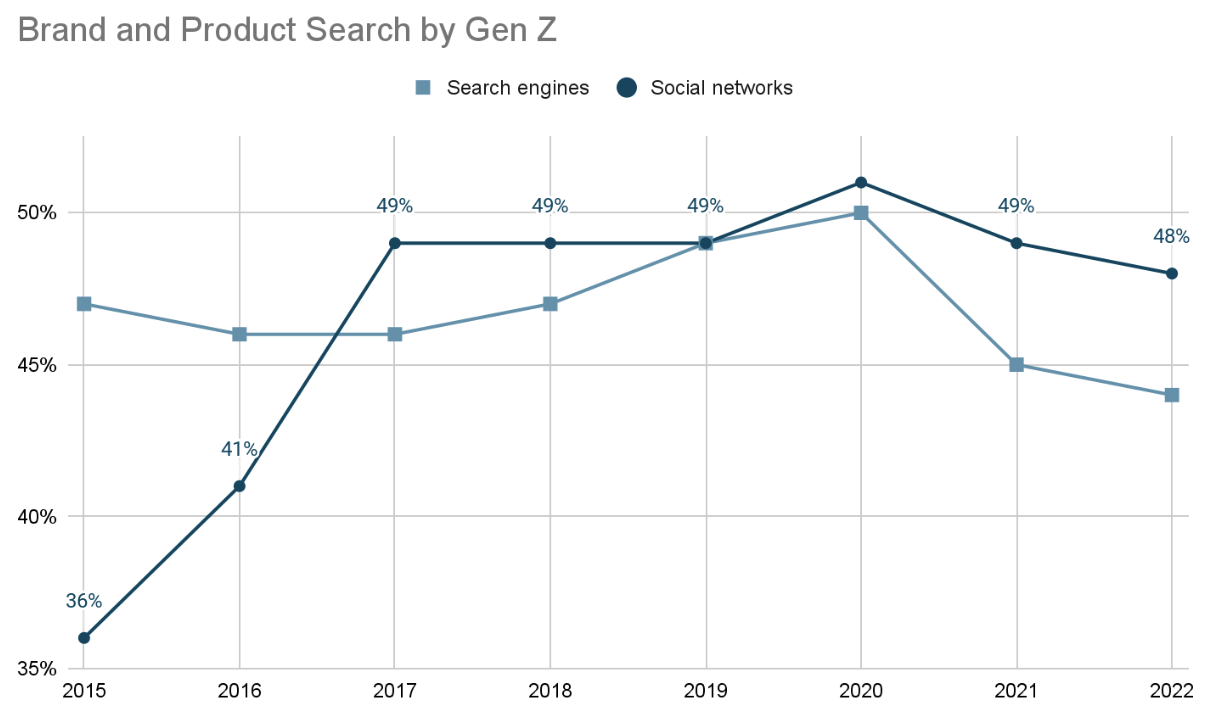How to Blend Online and Offline Sales Strategies
From open-air markets and physical stores to TV commercials and now social media, the retail industry has undergone an extensive evolution. While companies are spending more and more on online sales strategies, ignoring offline media can be a huge mistake. In fact, despite the pandemic impacting our shopping habits, eCommerce makes up only 15% of all sales. The remaining 85% of purchases still take place in traditional physical stores.
To achieve maximum results, marketers blend both online and offline approaches. Companies can improve their sales strategies and expand their reach by managing both their digital and physical presence. In this article, we will look at the market's current state and propose ideas on how to merge your strategies efficiently.
Click on each corresponding link to jump ahead:
- The Current State of Retail for Mid-Market Businesses
- 7 Steps to Take for Blending Online and Offline Sales Strategies
- Conclusion
If you require assistance with merging your online and offline sales strategies or you require a website audit, contact us today.
1. The Current State of Retail for Mid-Market Businesses

Sephora has done an excellent job of blending its online and offline sales strategies. Source - Sephora
Mid-market businesses or small and medium-sized enterprises (SMEs) generate between $10 million and $1 billion in annual revenue. Companies with a $10 million annual revenue have
drastically different needs compared to higher-tiered businesses.
For example, a smaller company may focus on growing profit while battling rapidly increasing expenses brought by expansion. On the other hand, a bigger organization is more concerned with marketing, recruiting, and R&D.
Overall, organizations worldwide are dealing with many challenges this year, including:
- Inflation
- Disrupted supply chains
- Transforming labour market
While the COVID pandemic has led to shortages across multiple products and solidified the era of remote work, the war in Ukraine amplified this disruption.
Successfully developing and executing marketing and sales strategies for SMEs requires continuous innovation. To streamline your business activities, you must rely on:
- Real-time data
- Analytics tools
- Market research
In the absence of a one-size-fits-all solution, business owners fail to implement an effective strategy, leading to poor decisions. Paired with undefined goals, your marketing and sales efforts can be lacklustre or even harmful. Above all, a poor grasp of your customers’ needs and wants complicates the business even further.
Finally, SMEs have to constantly adjust to the ever-changing customer trends. From the rise of online shopping, which modified the entire retail landscape, to personalization trends, businesses struggle to meet the demands they continually face. Customers are more conscious about the environment and their health and are more concerned about the brand’s ethics and reputation. As a result, establishing and maintaining a good public image is highly difficult.
2. 7 Steps to Take for Blending Online and Offline Sales Strategies
The world of eCommerce is not a new concept. Businesses are successfully applying online sales strategies to reach wider audiences and boost brand awareness. However, merging online and offline sales enablement strategies may help you empower your efforts even more. In this section, we will focus on actionable steps to create an omnichannel presence.
A) Assess Your Business's Current Position
Analyzing your existing situation is crucial before blending your online and offline strategies. Begin by comparing your current position against your established goals to identify potential issues and make any necessary adjustments. Review your KPIs to determine whether you are on the right track. For example, check your traffic and compare it against your objectives to see if your previous strategy was effective or not.
Another helpful factor for assessment is MROI or Marketing ROI. Calculate the acquisition cost to see whether your current efforts are worth the amount you’re spending. Additionally, focus on metrics such as the lifetime value (LTV) and cost per outcome (CPO). Your goal is to identify the weak spots and readjust your marketing activities to strengthen them.
B) Enhance Offline Customer Experience
Mirrors with augmented reality.
Even though online shopping is more popular than ever, brick-and-mortar is far from obsolete. With 85% of all sales taking place in physical stores, companies should hone in on their offline strategies. However, shoppers prefer brands that provide personalized experiences instead of the classic and traditional brick-and-mortar.
Companies that go the extra mile to enhance the shopping experience are more likely to succeed. For example, clothes brands adopt mirrors with augmented reality (AR) in their stores for customers to try on an outfit virtually. AR and VR technologies are also widely used by beauty companies to demonstrate their products, and used by furniture shops to create interior designs.
A newer concept called shoppable supermarkets has also been gaining traction in retail. To enhance customer experience, physical stores install systems that detect whenever a buyer picks up or puts back an item. Businesses can automate the transfer of this information to a virtual shopping cart in real-time using:
- Deep learning
- Computer vision
- Sensors
As a result, customers no longer need to waste their time in line and can pay for their items using online payment services.
C) Strengthen Your Online Sales Platform
Now that you know which areas need improvement, you can move on to empowering your online sales platforms. Pay close attention to your Google rankings to enhance your SEO activities and make your platform design more responsive. Consider also providing high-resolution images to improve customer experience. Furthermore, ensure that your website is searchable and allows users to find the desired product swiftly and easily.
Another vital part of online sales strategies is your social media presence. Nowadays, 43% of internet users shop on social media sites. Thus, you must recognize the importance of a coherent and consistent marketing omnichannel plan. Your posts across social media accounts should be different yet holistic. For instance, while you can post once a day on Facebook, X (formerly Twitter) performs better with at least five tweets per day.
Take a look at how often users abandon their shopping carts to determine the level of your success. If the percentage is high, email reminders and push notifications can improve this metric. Businesses can also implement a live chat function to help customers navigate the website.
D) Craft a Cohesive Customer Journey
Organizations that strive to maximize the efficiency of their sales strategies and blend online and offline marketing efforts. Since marketing is inherently customer-centric, a holistic design and tone of voice across multiple channels is crucial to boosting brand awareness.
Begin by identifying the online and offline channels your customers will likely use. For example:
- Gen Z mainly uses social media to search for products, as opposed to traditional search engines (shown in the graph below)
- For Gen X, social media is relevant, but unlike previous generations, they also make purchasing decisions based on TV ads.
Investigate your target audience to add precision to your marketing efforts and reach specific shoppers.

Source: Statista
After getting to know your crowd, explore customer journeys to create a seamless shopping experience. Starting with initial touchpoints like social media and physical stores, follow the journey that your buyers make. Referred to as mapping, this technique allows you to test how well your customers’ experience works and find and fix any roadblocks.
Sephora is among the best online and offline sales strategies examples. This beauty brand provides a great customer experience by using social media for sales prospecting. Additionally, they revolutionized brick-and-mortar shopping by adopting AR mirrors.
E) Leverage Technology and Automation
Companies can rely on various tools to optimize and automate sales strategies. CRM is probably the most useful tool for marketing and sales activities. These systems improve efficiency and visibility by allowing you to store, organize, and monitor customer information across your channels.
Among the most popular sales intelligence tools are:
Numerous big players like Spotify and Toyota decided to hire dedicated Salesforce developers to seamlessly integrate their current systems with a CRM. For example, BPCL (Bharat Petroleum Corporation Limited) relies on Salesforce CRM to:
- Capture leads
- Track sales pipelines
- Enhance customer experience
Channel integration is an effective way of synchronizing your offline and online sales strategies. It’s a process of tethering your business intelligence and sales automation tools to each other to gain a comprehensive overview. This technique helps you:
- Eliminate data silos
- Remove discrepancies
- Create a holistic view of your eCommerce and marketing achievements
Another helpful solution to improve your sales strategies and tactics is the use of data analytics platforms. Set up and track vital metrics through channel analytics tools to identify the performance of your channels.
F) Data Integration and Analysis
You can apply various sales management tools to merge online and offline sales channel strategies. By studying your customer data from your website and social media, you can identify the most popular products. This information will guide you in stocking brick-and-mortar more efficiently. Accumulated user data will also aid you in learning more about:
- Your customers
- Their shopping habits
- Their preferences
However, data management is a big part of aggregating and analyzing information. Make sure your information is secured and protected against cyberattacks. Additionally, remember to back up your data regularly to avoid huge losses. It’s also imperative to always ask for consent when collecting user information to prevent lawsuits and damage to your reputation.
G) Measure Success and Make Adjustments
There are a few integral key performance indicators that enable business owners to assess their sales strategies. To measure brand awareness, companies rely on:
- Cost per impression (CPM)
- Website traffic
- Social media engagement
Cost per user acquisition and average order value allow marketers to gauge how well their content converts prospects into buyers. Finally, monitor lifetime value and churn rate to assess customer retention.
However, consistency is the key to success. Research from HubSpot shows that continuous training increases sales performance by 50%. Invest in training and development to help your employees grow professionally and reach new heights. Additionally, organizations that are more quick to adjust to the changing market perform better. Make sure your business encourages innovation and is ready to adapt.
3. Conclusion
Based on our offline and online sales strategies examples, blending both approaches can be highly beneficial for you. By acquiring data from one source and utilizing it to improve another, you can enhance the quality and precision of your sales management tactics.
Pushing a consistent message across platforms creates a more recognizable image and facilitates customer loyalty. Consider merging your sales strategies to improve the efficiency of your marketing efforts and increase sales.
Author’s Bio
Vitalii Makhov, CEO at DOIT Software, an IT Staff Augmentation company. The DOIT Software team is passionate about building bold systems and solving business challenges for startups, product companies, and digital agencies.

